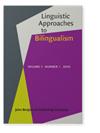The acquisition of consonant clusters and word stress by early second language learners of German
IF 1.8
2区 文学
0 LANGUAGE & LINGUISTICS
引用次数: 0
Abstract
This study compared word-prosodic abilities of early second language learners (eL2) and monolingual learners of German. We examined the production of word-initial and word-final clusters and the placement of stress and analyzed potential effects of cross-linguistic influence (CLI). Monolingual German-speaking children (n = 38) and eL2-learners of German (n = 26; age of onset to German 24 to 41 months) aged between 53 and 60 months completed a pseudoword repetition task following the metrical and phonotactic constraints of German. We collected background information via parental questionnaires. The eL2-learners acquired 12 different L1s. To explore the effects of CLI, we grouped the heritage languages by the number of consonants permitted in word-initial and word-final position, the segmental make-up of clusters, and stress patterns. The production accuracy of word-initial clusters and word stress was very high, indicating a high degree of maturation and showing no effects of CLI. In contrast, the production accuracy of word-final clusters was lower and effects of CLI were found, presumably related to smaller sonority distances compared to word-initial clusters. The study contributes empirically to the under-investigated area of eL2 word-prosodic development.早期德语第二语言学习者对辅音群和单词重音的习得
本研究比较了早期第二语言学习者(eL2)和单语言德语学习者的单词韵律能力。我们考察了词首和词尾词组的产生以及重音的位置,并分析了跨语言影响(CLI)的潜在作用。年龄在 53 到 60 个月之间的德语单语儿童(38 人)和德语 eL2 学习者(26 人;开始学习德语的年龄为 24 到 41 个月)按照德语的韵律和语音战术限制完成了一项假词重复任务。我们通过家长问卷收集了背景信息。eL2 学习者获得了 12 种不同的 L1。为了探究 CLI 的影响,我们根据词首和词尾位置允许使用的辅音数量、词组的分段构成和重音模式对遗产语言进行了分组。单词词首音簇和单词重音的发音准确率非常高,表明语言已经高度成熟,而且没有受到 CLI 的影响。相比之下,词尾音簇的发音准确率较低,而且发现了 CLI 的影响,这可能与词首音簇的声调距离较小有关。这项研究为研究不足的 eL2 单词韵律发展领域做出了经验性贡献。
本文章由计算机程序翻译,如有差异,请以英文原文为准。
求助全文
约1分钟内获得全文
求助全文
来源期刊

Linguistic Approaches To Bilingualism
Social Sciences-Linguistics and Language
CiteScore
3.20
自引率
9.10%
发文量
24
期刊介绍:
LAB provides an outlet for cutting-edge, contemporary studies on bilingualism. LAB assumes a broad definition of bilingualism, including: adult L2 acquisition, simultaneous child bilingualism, child L2 acquisition, adult heritage speaker competence, L1 attrition in L2/Ln environments, and adult L3/Ln acquisition. LAB solicits high quality articles of original research assuming any cognitive science approach to understanding the mental representation of bilingual language competence and performance, including cognitive linguistics, emergentism/connectionism, generative theories, psycholinguistic and processing accounts, and covering typical and atypical populations.
 求助内容:
求助内容: 应助结果提醒方式:
应助结果提醒方式:


